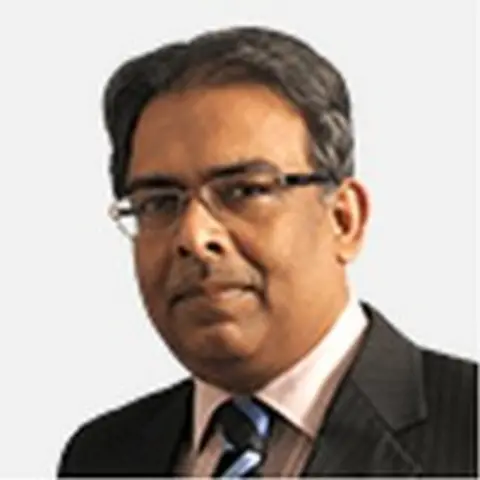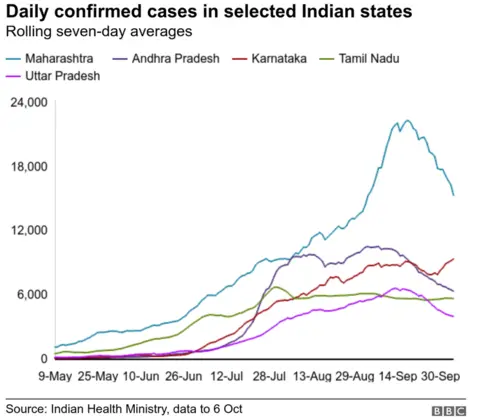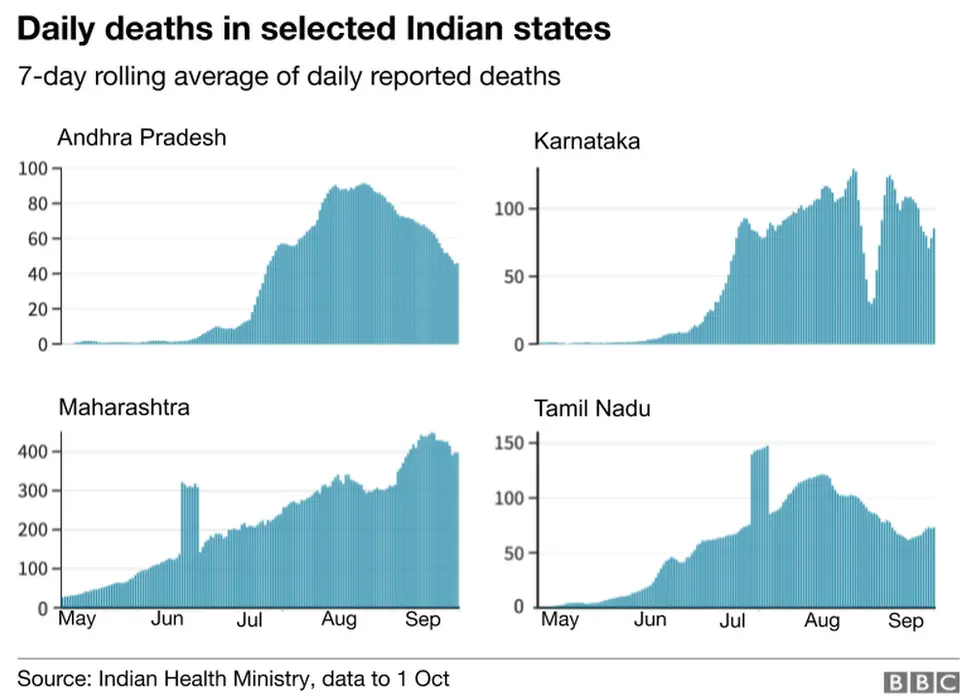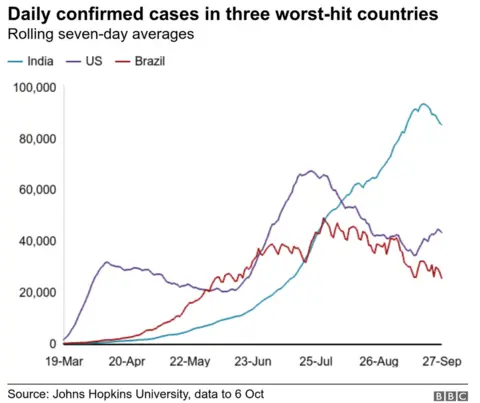Coronavirus: Is the pandemic slowing down in India?

 Reuters
ReutersAfter six-and-a-half million cases, and more than 100,000 deaths, is the coronavirus pandemic slowing down in India?
Consider this.
India has been recording an average of more than 70,000 cases daily so far this month, down from more than 86,000 daily cases in the last two weeks of September. It's also a steep drop from earlier in September, when daily cases averaged around 93,000. Daily deaths too have been declining in most states. But testing has remained consistent.
More than 1.1 million samples have been tested daily on an average so far in October, up from 70,000 in August. Last month, 1.05 million samples, on an average, were tested daily.
So, on the face of it, it appears there has been a slowdown in case numbers. But epidemiologists I spoke with say the numbers should be interpreted with caution.

They believe that the recent decline in cases and deaths is a promising signal, but it's far too early to say that the pandemic is receding.
For one, just high testing and declining case counts may not be enough to come to a conclusion. Half of the total tests India is conducting are the rapid antigen ones.
They are quicker and cheaper, but also less reliable, with accuracy in some cases as low as 50%. The PCR (polymerase chain reaction) test, which isolates genetic material from a swab sample and is the gold standard of testing, is more expensive and results takes longer.
"How much of India's declining case numbers have been contributed by these rapid tests, and how much of it is a real slowdown is difficult to say," Dr Shahid Jameel, a leading virologist, told me.
He said scientists will know for certain only if the government releases data on how many PCR and antigen tests are being done, which can then be compared with the daily case load.
India has also allowed on-demand testing, which may inflate test numbers of asymptomatic persons, according to Dr K Srinath Reddy, president of the Public Health Foundation of India, a Delhi-based think tank.
On the other hand, antibody surveys and epidemiological models suggest that the burden of India's hidden infections remains large.
India already has around 120-130 million infections, estimates Dr Bhramar Mukherjee, a professor of biostatistics and epidemiology at the University of Michigan who has been closely tracking the pandemic. That's less than 10% of the population. Countrywide antibody tests alone suggest 90 million Indians - about 15 times the official caseload - have had the infection.
"There is still a lot of forest left for the virus to spread like wildfire," Dr Mukherjee told me. "Let us try to keep it as a slow burning coil. We also want to give our health care system time to replenish, recharge, restock."
So what would be the best way to assess if the pandemic is slowing?
Track deaths, suggests Dr Reddy.

"Even if there is some underreporting, a steady and sustained fall in Covid-19 death rates, as a moving seven day average, may be even more suggestive of a genuine downward trend. We have to watch for that," he says.
Pandemics go through four main stages - spark, growth, peak and decline, according to Adam Kucharski, a scientist at the London School of Hygiene and Tropical Medicine who studies how diseases spread. In some cases, he says, these stages will appear multiple times. When the swine flu pandemic arrived in UK in April 2009, it grew rapidly in early summer, peaked in July, then grew and peaked again in late October.
Take the countries with large number of Covid-19 cases - US, UK, Russia and France. The US, say epidemiologists, is entering its third phase of growth after campuses reopened in the fall, and 22 states reported a spike in case numbers. The other countries are all in their second peak.

So any feeling of security is "transient and ephemeral", says Dr Mukherjee. India's busy festival season is around the corner. This is when people and families get together. A few 'superspreader' events and increased mobility can again change the course of the virus in two weeks, she adds.
"This is not a state of containment or complacence," says Dr Mukherjee. "We will have to get used to this pause, restart, drive mode of cruising till half of the world gets inoculated. That is the unfortunate reality."
So keep your mask on, wash your hands and stay away from crowded places.
Charts by Shadab Nazmi

Read more stories by Soutik Biswas


What do I need to know about the coronavirus?
- ENDGAME: When will life get back to normal?
- EASY STEPS: What can I do?
- A SIMPLE GUIDE: What are the symptoms?
- MAPS AND CHARTS: Visual guide to the outbreak
- VIDEO: The 20-second hand wash

